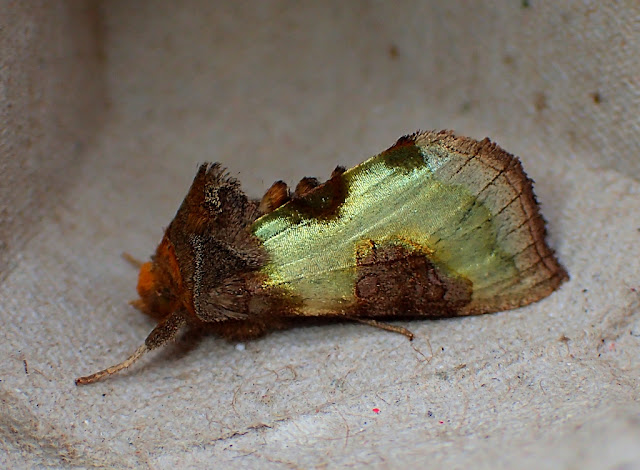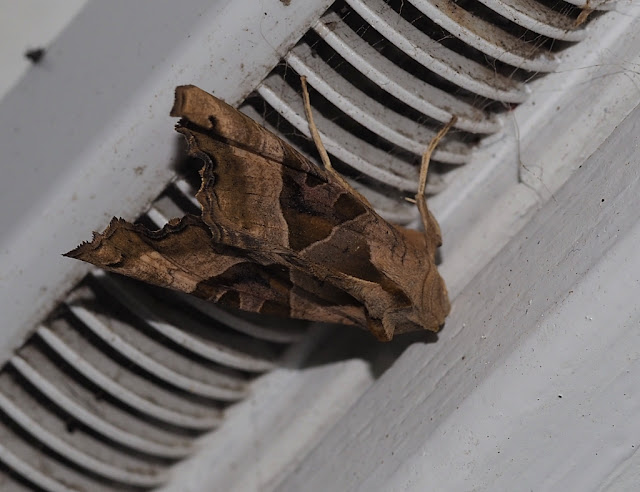I've arrived at the time to count up how many new species for me, lifers, NFM (new for me, moffers shorthand) that I've seen this year. A bit early to stop now you might say, there are still several weeks of the year left, but, actually I stopped a month or so back as I decided it was all too much like working, and anyway it had served it's purpose. I have found out what I like doing and what is a bit of a chore. The concept itself is a bit of a chore, indeed.
I guess I'll have a go at identifying most things but some are a bit frustrating to work on. As well as birds and mammals, it's moths and beetles that I really like and am most interested in. I think that's where next year's efforts are likely to be focused. I want to continue to improve my botanical skills, slowly but surely. I'm sure I'll continue to dabble at other things, and as I continue to be county hoverfly recorder I ought to make a bit more effort with them, although I have added one species to the county list this year.
 |
| Philonthus politus, male and his aedegus. |
Of botany, quite a few things flowering at the moment, I found Ragged Robin and Marsh-marigold to be the most surprising.
 |
| Marsh-marigold. |
 |
| Ragged Robin. |
These were both at nearby Loch of Bosquoy in the wonderful hay meadows, well, wonderful until they changed hands after the 20 year scheme had ended and the new owner went in with the herbicide. So 20 years of public money and a very effective result thrown away for private profit (I'm not even going to mention the climate crisis in this regard, honest). There are remnants of their past glory, but I suspect if it shows too much the herbicide will be reapplied. I informed NatureScot at the time, and that was a waste of my time, nothing they can do even if they had the staff and resources. I don't actually blame the farmers, they're just doing their job, doing what they do, it's the system that's completely useless. Not fit for purpose. If the Scottish Government are going to finance schemes like this it needs to be forever, otherwise it's a waste of everyones' time and money.
Today was Blackbird day, they were everywhere in numbers. In the end I counted 37 on the 1km patch but that's surely an under-count as I think they were moving through. At one point there were 13 on the front grass. 37 is a record count with only 20th November 2011 coming close with 35 counted; lots of counts of 20 or so in the past but otherwise 27 was the third highest total. 161 Redwing and a likely Jack Snipe were the other highlights. There was a tagged Buzzard, I couldn't read the wing-tags as it did it's flappy thing past the kitchen window, the Long-tailed Duck is still enjoying her new home, and the 1cy Hen Harrier was hunting the Hawthron hedge and meadows again.
 |
| Blackbird (archive image, light was a bit rubbish today). |
Very interesting paper in the latest Atropos about Fused (Cryptic) Burnished Brass and whether it is a good species and whether it occurs in the UK. It's probably not identifiable except using barcoding, but there are apparently subtle genitalia differences. If the gap between the brown colouration is more than 3mm, that's a good guide, apparently. It is suggested the species is also slightly smaller. Interestingly, I caught this one in the garden in June 2020.
 |
| Fused (Cryptic) Burnished Brass Diachrysia stenochrysis, maybe... |
Diachrysia stenochrysis is an accepted species in Europe and Asia, however, apparently not so in the UK, although NBN lists 33 confirmed records, it would be interesting to know who verified these records and how? The paper has raised a bit of discussion on Twitter, at least. I guess this is an evolving story, just taking a while to evolve. In the meantime where do we send likely contenders? An interesting question raised on Twitter (despite its built in impediment to proper discussion and its completely mad thread structure) is that could individuals with the brown bar joined also possibly be D. stenochrysis? (I thought this was an excellent question.) Interestingly, the GBIF website does illustrate individuals which have a nearly or just joined brown bar as D. stenochrysis, again one wonders how these were determined. I think the Atropos paper does a good job of following up the question that SC raised in his 2012 book Moths of Great Britain and Ireland (a very handy book I find). I'm not sure who the taxonomic determiners are for moths. For birds in the UK it works like this - https://bou.org.uk/british-list/taxonomy/ (I think a branch of GBIF does this, GBIF Backbone Taxonomy.) I guess a consensus will eventually appear and be agreed, in the meantime I'll keep any of interest I catch, although to be of use for barcoding I believe the analysis needs to take place pretty sharpish. Anyone out there got some dosh and connections to the appropriate university department to sponsor and support a couple of PhDs?
I light trapped on Friday night and drew a blank but Saturday was better and produced an Angleshades and eight Mottled Umber.
 |
| Angleshades. |
 |
| Mottled Umber. |
 |
| Mottled Umber. |

No comments:
Post a Comment